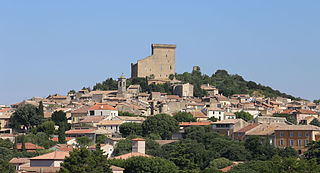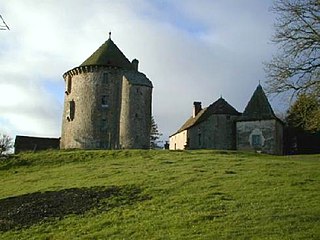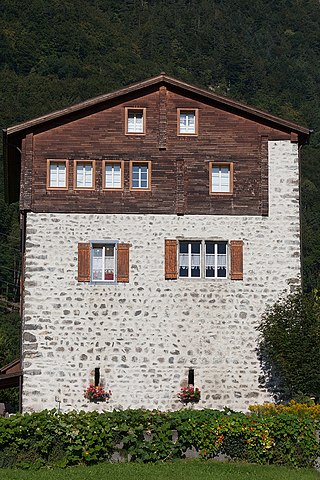
Aigues-Mortes is a commune in the Gard department in the Occitania region of southern France. The medieval city walls surrounding the city are well preserved. Situated on the junction of the Canal du Rhône à Sète and the Chenal Maritime to Le Grau-du-Roi, the town is a transit center for canal craft and Dutch barges.

Ravensburg is a city in Upper Swabia in Southern Germany, capital of the district of Ravensburg, Baden-Württemberg.

Châteauneuf-du-Pape is a commune in the Vaucluse department in the Provence-Alpes-Côte d'Azur region in Southeastern France. The village lies about 3 kilometres (1.9 mi) to the east of the Rhône and 12 kilometres (7.5 mi) north of the town of Avignon. As of 2019 the commune had a population of 2,055.

A keep is a type of fortified tower built within castles during the Middle Ages by European nobility. Scholars have debated the scope of the word keep, but usually consider it to refer to large towers in castles that were fortified residences, used as a refuge of last resort should the rest of the castle fall to an adversary. The first keeps were made of timber and formed a key part of the motte-and-bailey castles that emerged in Normandy and Anjou during the 10th century; the design spread to England, south Italy and Sicily. As a result of the Norman invasion of 1066, use spread into Wales during the second half of the 11th century and into Ireland in the 1170s. The Anglo-Normans and French rulers began to build stone keeps during the 10th and 11th centuries; these included Norman keeps, with a square or rectangular design, and circular shell keeps. Stone keeps carried considerable political as well as military importance and could take up to a decade or more to build.

Dinkelsbühl is a historic town in Central Franconia, a region of Germany that is now part of the state of Bavaria, in southern Germany. Dinkelsbühl is a former free imperial city of the Holy Roman Empire. In local government terms, Dinkelsbühl lies near the western edge of the Landkreis of Ansbach, north of Aalen.

Altstadt is the German language word for "old town", and generally refers to the historical town or city centre within the old town or city wall, in contrast to younger suburbs outside. Neustadt, the logical opposite of Altstadt, mostly stands for a part of the "Altstadt" in modern sense, sometimes only a few years younger than the oldest part, e. g. a late medieval enlargement.

A water castle is a castle whose site is largely defended by water. It can be entirely surrounded by water-filled moats or natural waterbodies such as island castles in a river or offshore. The term comes from European castle studies, mainly German Burgenkunde, but is sometimes used in English-language popular science books and websites, and is mentioned in other more academic works. When stately homes were built in such a location, or a Wasserburg was later rebuilt as a residential manor, the German term becomes Wasserschloss, lit. "water palace/manor".

The Château de Couffour or Tour du Couffour is a ruined castle situated in the French commune of Chaudes-Aigues in the Cantal département.

Rapperswil Castle is a castle, built in the early 13th century by the House of Rapperswil, in the formerly independent city of Rapperswil.

Rathaus Rapperswil is the former Rathaus of the city government of medieval town of Rapperswil, Canton of St. Gallen in Switzerland. Today, the building houses a café and restaurant, the city archives and a collection of stained glass windows, silverware and paintings. The building and the city archives are listed in the Swiss inventory of cultural property of national and regional significance.

Stadtmuseum Rapperswil-Jona is a museum of local history and art in Rapperswil, canton of St. Gallen in Switzerland.

Schweinsberg Castle or Schweinsberghaus is a fortified house in the municipality of Attinghausen in the canton of Uri in Switzerland. It is a Swiss heritage site of national significance.

The Felsenburg is a fortified castle and tower in the city of Bern, Switzerland. It is part of the UNESCO Cultural World Heritage Site of the Old City of Bern and, together with the adjacent Untertorbrücke, it is a cultural property of national significance

A flanking tower is a fortified tower that is sited on the outside of a defensive wall or other fortified structure and thus forms a flank. From the defensive platform and embrasures the section of wall between them could be swept from the side by ranged weapons. In High and Late Medieval castles and town walls, flanking towers often had a semi-circular floor plan or a combination of a rectangular inner and semi-circular outer plans. There were also circular and rectangular towers. Corner flanking towers are found, for example, in the fortifications of the Alhambra and at the manor house of Hugenpoet Palace; Wellheim Castle has a square flanking tower. Semi-circular flanking towers were common in Sasanian architecture.

Gothic architecture is a style of architecture that flourished during the high and late medieval period. It evolved from Romanesque architecture and was succeeded by Renaissance architecture.

The Grynau Castle is the name of a castle tower in the municipality of Tuggen in the canton of Schwyz, built by the House of Rapperswil in the early 13th century AD.

Alt-Regensberg Castle is a hill castle which was built about the mid-11th century AD by the House of Regensberg in the Swiss municipality of Regensdorf in the Canton of Zürich.

Uster Castle is a hill castle which was built probably around 1200 AD by the House of Rapperswil in the Swiss municipality of Uster in the Canton of Zürich. Since 1995 it houses a boarding school.

Einsiedlerhaus is a historic building with an adjoint garden which is part of the former town wall of the medieval Swiss town of Rapperswil in the Canton of St. Gallen.




























